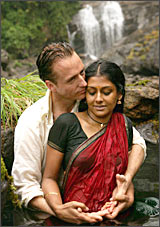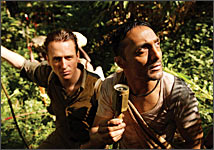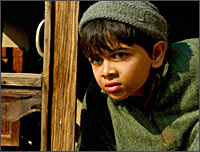 | « Back to article | Print this article |
Santosh Sivan has become truly an international filmmaker. His eighth directorial venture, Before the Rains, a Hollywood film made in Kerala has made it to a number of international film festivals namely Edinburgh, Toronto, Pusan and Palm Springs.
His film also won the Best Film Award, the Kodak Crystal Vision Award for Best Cinematography and the Best Music Director award (for Mark Killian) at the Houston film festival.
Now, the latest feather in his cap is a feature on the film which appeared in the prestigious American Cinematographer magazine (this is the second time that the magazine has done a feature on him, the first being when he made The Terrorist).
In this exclusive interview, Santosh Sivan tells Shobha Warrier why it is a big deal to be featured in the magazine.
This is the second time that we have a feature on you in the American Cinematographer. How does it feel?
 It is interesting because the magazine is perhaps the only one of its kind that discusses the visual language of a film. Though a Hollywood film, Before the Rains was shot completely in Munnar, Kerala.
It is interesting because the magazine is perhaps the only one of its kind that discusses the visual language of a film. Though a Hollywood film, Before the Rains was shot completely in Munnar, Kerala.
The magazine is always on the lookout for innovative techniques, purity and the "non-Hollywood" in films. The visual texture of Before the Rains has true Indian sensibilities and that has always attracted the magazine. As I am from Kerala, the sensibilities are a reflection of the Kerala folk and visual arts. All the visual influences are from the grandmother's tales to Raja Ravi Varma's paintings.
The article has praised the way you blended the theme of the film and the visual design. You said in the article that you were influenced by Satyajit Ray in doing so. The story of Before the Rains happens in Munnar. How did you incorporate the landscape and the theme and the characters in the film?
The film is a drama about different cultures interacting, and the different cultures are always curious about one another. It's a timeless phenomenon; this fatal attraction. The premise for the story is the late 1930's when in a remote part of India, a planter (Linus Roache) aided by his worker and friend (Rahul Bose) builds a road in the hills for spice trade. So, the story is about the clash in two cultures, and also as an intrusion into nature.
Can you elaborate on how the concept of contrast extended to lighting?
Well it's interesting if you were to witness a Kathakali performance, or any such art form. In its pure form, it is almost a performance to God, hence they light a lamp and perform in that glow. It is highly dramatic and I have been fascinated by it. I did use those observations while filming Vaanaprastham and also Perumthachan.
How challenging was it to light the rainy and misty exteriors of Munnar?
 Of course, Munnar has retained its eco-balance, thanks to the Tata Tea estates and the government. I filmed Munnar during times of transition -- when night turns to day and when seasons change. These are fleeting, but beautiful moments. We decided not to disturb the visuals by manipulating the colour correction to underline a period.
Of course, Munnar has retained its eco-balance, thanks to the Tata Tea estates and the government. I filmed Munnar during times of transition -- when night turns to day and when seasons change. These are fleeting, but beautiful moments. We decided not to disturb the visuals by manipulating the colour correction to underline a period.
You said you lit the interiors so that they looked like the Ravi Varma paintings. Why? You had even picturised a song like his paintings in the film Ananthabhadram.
Raja Ravi Varma paintings are one of the early visual influences in my life. To most Keralites, the paintings remind them of home. I often see these paintings adorn the homes of many Keralites in the US, Dubai and the UK. Raja Ravi Varma paintings have a fusion of Indianness and influences of the renaissance.
You said the most challenging part of the film was the construction of a road. Why was this?
Well, its really difficult trying to build a road through a forest. Fortunately we found an abandoned one.
 Though the film was set in the 1930s, you didn't give it a period look. Why?
Though the film was set in the 1930s, you didn't give it a period look. Why?
The tea estates in Munnar haven't changed that much in the last 75 years. Hence we used costumes and art direction to bring out the period.
When will the film be released in India?
I think by the end of the year although it has been released in the US and UK.
What is your next project?
My next project is Tahaan. It is a Hindi film shot in Kashmir, about a little boy (Purav) and his donkey. Anupam Kher, Rahul Bose, Victor Banerjee, Rahul Khanna and Sarika are also starring in the film. It is already complete and will release during September or October.